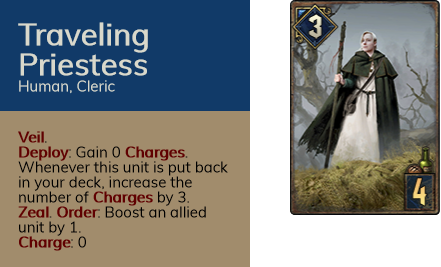Introduction
Travelling Priestess added in the Forgotten Treasures expansion immediately became the most significant 4 provision bronze in the game (Gwent 10.4).

Travelling Priestess gains 3 charges whenever put back into the deck. This includes Mulligan phase – Travelling Priestess mulled out gains charges!
At the moment this article is written, we witness great popularity of decks crafted specially to maximize Priestess value with deck/hand manipulation tools like Istredd, Snowdrop, Griffin Witcher Mentor…
In this study though we would analyze the natural (raw) value of Traveling Priestess without support of deck/hand manipulation cards.
Priestess Without Support
How good is Priestess by itself?
Let’s assume there is no support for Priestess in a 25 cards deck, so that the only way to obtain charges on Priestess is by mulling it out during Mulligan phases. Priestess would always be primal mulligan target and all mulligans are used.
We also consider Priestess in the context of Amphibious Assault value, so that she could be shuffled into the deck in R3 for extra value and still played. Without AA playing natural Priestess makes little sense, which would be discussed later.
Obviously the real Priestess value would be higher in such model than in real games, because some flexibility on AA and mulligans is lost.
The only varied parameter in the model would be the number of cards thinned after Round 1. And the main question would be: How good is the Priestess on average in R3?
Natural Priestess Math
The problem of getting Priestess value is similar to the problem of finding a single card, but with one important difference. Not only drawing the card to the hand is needed, but also mulling it out during the same mulligan phase. Therefore, whenever Priestess is drawn as the last card, it’s value could not be activated in the same round. Such draw matters only as insurance for developing the value in the next round (‘offset’).
Double Is Different
Travelling Priestess is a bronze card, which means that 2x copies could be played in a deck. Is the value of 2x Princess equal to 2x value of a single Princess?
Not really. As 4 provision card, Priestess is a natural mulligan target and a weak Priestess (0 or 3 charges) lowers the deck power only if bricked in hand. On the contrary, a strong (6 or 9) Priestess probably improves pointslam value of Amphibious Assault. Having bad and strong Priestess as AA targets, only strong one value matters.
We would approximate both Priestess as independent of each other, and assume the total value as max of the two. Warning – this value would be even more elevated with respect to real games than in the case of single one.
Results
The source data for all results presented below is collected in a Google Sheet. By changing R1/R2 Thinning value in the main ‘SINGLE&DOUBLE’ tab you could observe how all probabilities and expected values change. Final power estimates could be read from ‘Results’ table.
Let’s have a look at value distribution in the case of Single/Double Priestess (red coin):
For every single Priestess without support, there is almost 50% chance of getting exactly 1 proc during the game. There is 25% chance of lowroll (no procs), and similar chance of a slight highroll (26%). Big highroll would happen in 4% of cases.
The possibility of choosing only the best one out of two Travelling Priestess has significant impact on expected value. In such case there is about 45/45 between 6p and 9p value. The probability of big highroll (8%) becomes greater than probability of big lowroll (6%).
The differences between coins are rather negligible (~0.1p), with blue being obviously slightly better for Priestess thanks to extra draw. Let’s have a look a thinning impact:
With 6.3p single and 7.6p double value, Travelling Priestess appears to be a decent 4 provision card, giving some opportunities to improve Amphibious Assault pointslam even when deck lacks thinning or any other support. The value of a single Priestess would be equal to weakest 4p bronzes in the meta, but with higher variance.
If having enough flexibility with mulligans, Priestess become consideration for any midrange NR deck playing AA. Also, natural Priestess value grows by about 0.2 points with every card thinned out in R1. In the case of very well thinning decks (4+), Priestess becomes 7+ points bronze.
The obvious drawback is Priestess unplayability in R1, R2 and in R3 best value could be achieved with AA only – R3 mulligans always contribute most on average to Priestess power.
Closure
Thanks for reading!
While the Priestess fashion may vanish someday, the thought process presented in this article will remain. For deeper understanding I’d recommend once again to lookup the sheet where presented values are computed step by step.


